If you’ve ever been curious about the existence of real purple snakes, you’ll be pleasantly surprised by what we’ve uncovered. These fascinating creatures, with their stunning shades of purple, are sure to captivate your attention.
From the Cape File Snake to the Western Blind Snake, from the Western Hognose Snake to the California Kingsnake with its popular purple passion morph, the world of these extraordinary reptiles is nothing short of mesmerizing.
But the question remains, are these snakes truly purple or is there something more to their appearance?
Examples of Real Purple Snakes
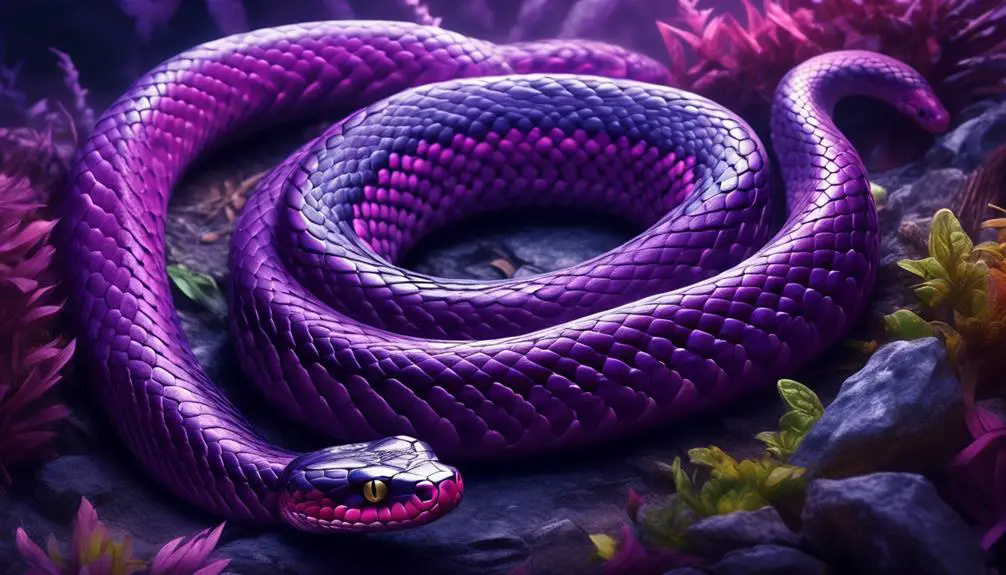
There are several real purple snakes that exist in nature, including the Cape File Snake, Western Blind Snake, Western Hognose Snake, California Kingsnake (Purple Passion Morph), and Ball Python (Purple Passion Morph).
Let’s start with the Cape File Snake, scientifically known as Limaformosa capensis. This snake can reach a length of 4.9 feet and has a lifespan of 15 to 20 years. It’s native to South Africa and can be found in coastal forests and savannas.
Next, we’ve the Western Blind Snake, also known as Rena humilis. This snake measures between 6 to 12 inches in length and weighs around 0.05 ounces. It’s found in arid lands of New Mexico, Southern California, Arizona, and Baja California. The Western Blind Snake is pink or purple in color and is adapted to living underground.
Moving on, we’ve the Western Hognose Snake, scientifically known as Heterodon nasicus. This snake reaches a length of 15 to 20 inches and weighs about 0.5 pounds. It has a lifespan of 10 to 20 years and is native to the central United States and east of the Rockies. The Western Hognose Snake is known for its ability to play dead.
Next up is the California Kingsnake, scientifically known as Lampropeltis california. This snake can grow to be 4 to 5 feet long and weigh between 0.9 to 3.3 pounds. With a lifespan of 15 to 20 years, the California Kingsnake is native to the west coast of North America and is popular as a pet snake.
Finally, we’ve the Ball Python, scientifically known as Python regius. This snake measures 4 to 5 feet in length and weighs between 3 to 5 pounds. It has a lifespan of 20 to 30 years and is one of the most common pet snakes, with over 4,000 morphs. The Ball Python is also known as the purple passion due to its distinctive purple coloring.
These examples highlight the diversity of real purple snakes and the fascinating characteristics of each species.
Cape File Snake
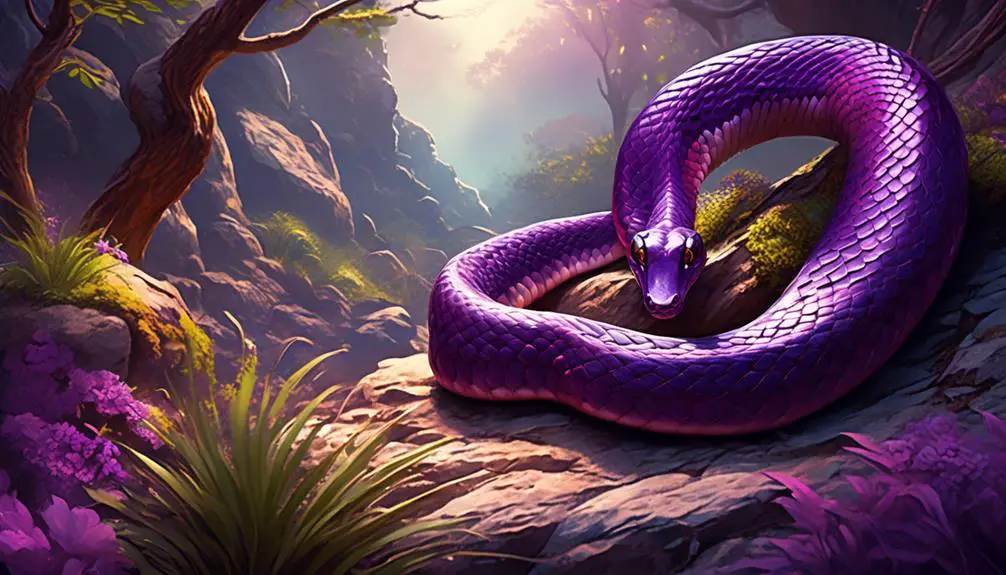
Now let’s turn our attention to the Cape File Snake, scientifically known as Limaformosa capensis.
This unique snake can reach a length of 4.9 feet and has a lifespan of 15 to 20 years.
Native to South Africa, the Cape File Snake is typically found in coastal forests and savannas.
Physical Characteristics and Habitat
The Cape File Snake, scientifically known as Limaformosa capensis, is a reptile that can be found in the coastal forests and savannas of South Africa. This snake has a slender body, reaching a length of approximately 4.9 feet. Its lifespan ranges from 15 to 20 years.
The Cape File Snake is native to South Africa and is well adapted to its habitat. It’s a nonvenomous species that primarily feeds on frogs, lizards, and small mammals. Its coloration is typically brown or olive, allowing it to blend in with its surroundings.
This snake is a skilled climber and spends a significant amount of time in trees, where it hunts for prey and seeks refuge from predators. Its ability to thrive in coastal forests and savannas makes it a fascinating species to study.
Lifespan and Geographic Distribution
The Cape File Snake, also known as Limaformosa capensis, has a lifespan ranging from 15 to 20 years. It is primarily found in the coastal forests and savannas of South Africa.
This snake species typically reaches a length of 4.9 feet. It’s native to South Africa and has adapted to its coastal habitat. The Cape File Snake is known for its slender body and distinctive file-like dorsal scales. These scales provide the snake with excellent grip and allow it to move effortlessly through its environment.
Despite its purple coloration, the Cape File Snake isn’t venomous and poses no threat to humans. Its geographic distribution is limited to the coastal regions of South Africa, where it thrives in the diverse ecosystems of the coastal forests and savannas.
Western Blind Snake
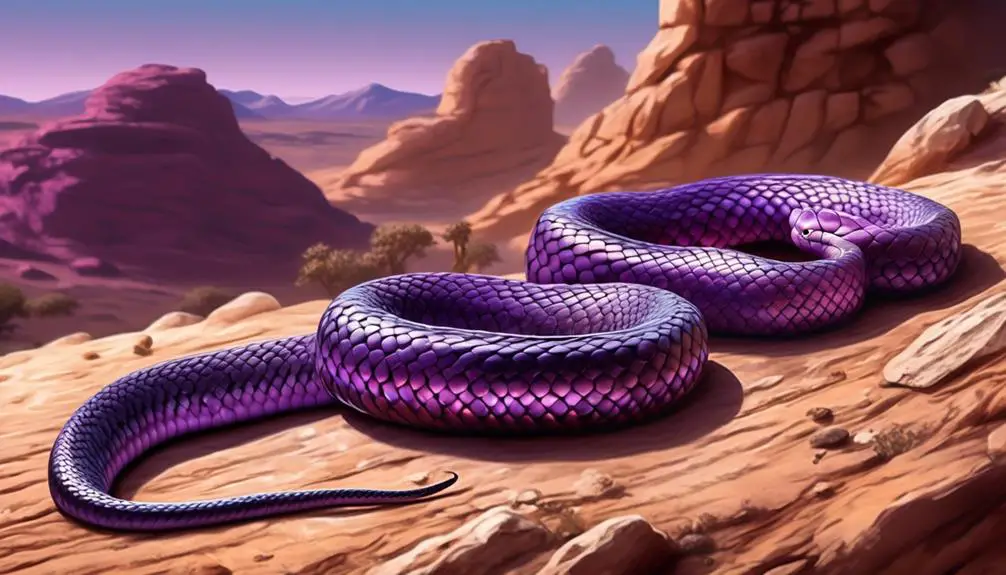
Western Blind Snakes, also known as Western worm snakes or western slender blind snakes, are small, pink or purple-colored snakes that are adapted for living underground. Scientifically named Rena humilis, these snakes measure around 6 to 12 inches in length and weigh about 0.05 ounces. They’re found in the arid lands of New Mexico, Southern California, Arizona, and Baja California. With their unique coloring, they blend well with the soil and debris in their underground habitat.
These snakes have slender bodies and small heads, which allow them to navigate through narrow tunnels and burrows. Their eyes are vestigial and covered with scales, making them functionally blind. However, their sense of touch and smell are highly developed, allowing them to locate their prey, which consists mainly of ants and termites.
Western Blind Snakes spend most of their lives beneath the surface, rarely venturing above ground. They’re known to occupy a variety of habitats, including deserts, grasslands, and even urban areas. Their diet, which consists primarily of small invertebrates, makes them beneficial to ecosystems by helping control pest populations.
Despite their coloration and underground lifestyle, Western Blind Snakes aren’t venomous and pose no threat to humans. In fact, they’re harmless and shy creatures that are rarely encountered. These fascinating snakes have evolved to thrive in their subterranean environment, showcasing the diversity and adaptability of snake species.
Western Hognose Snake
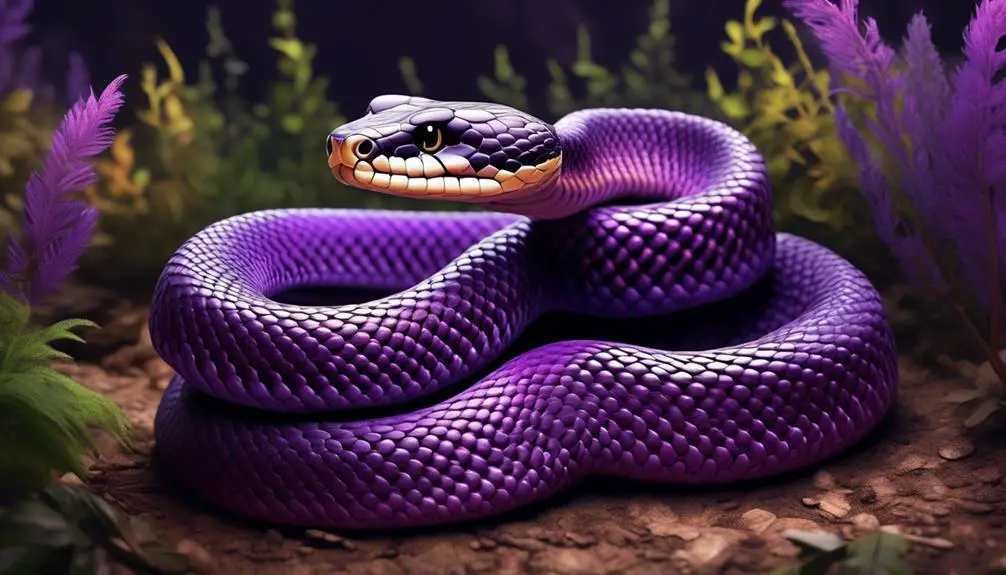
With its unique adaptations and fascinating behavior, the Western Hognose Snake showcases yet another remarkable example of the diversity and ingenuity of snake species. Scientifically known as Heterodon nasicus, the Western Hognose Snake is commonly referred to as the Hognose. This snake species typically reaches a length of 15-20 inches and weighs around 0.5 pounds. With a lifespan of 10 to 20 years, the Hognose is native to the central United States and the eastern Rocky Mountains.
One of the most notable features of the Western Hognose Snake is its ability to play dead when threatened. When confronted, the snake will first flatten its head and neck, hiss loudly, and strike with a closed mouth. If these defensive maneuvers fail to deter the predator, the Hognose will dramatically roll onto its back, open its mouth, and protrude its tongue. This behavior, known as ‘death feigning,’ is accompanied by convulsions and the release of a foul-smelling musk. By pretending to be dead, the Hognose Snake tricks potential threats into thinking it’s a harmless corpse.
The Western Hognose Snake is a primarily terrestrial species, found in a variety of habitats such as grasslands, sand dunes, and open woodlands. It’s a nonvenomous snake and primarily preys on small mammals, frogs, toads, and lizards. The Hognose Snake has a unique adaptation that allows it to specialize in feeding on toads. It possesses a specialized set of teeth in the rear of its upper jaw that helps it puncture and deflate the toad’s poison glands, allowing the snake to safely consume its prey.
In terms of appearance, the Western Hognose Snake can vary in coloration and pattern, but it isn’t typically purple in color. It often has a brown, tan, or olive base color, with dark blotches or speckles along its back. Some individuals may display a pink or orange hue, but true purple coloration isn’t a characteristic of this species.
California Kingsnake (Purple Passion Morph)
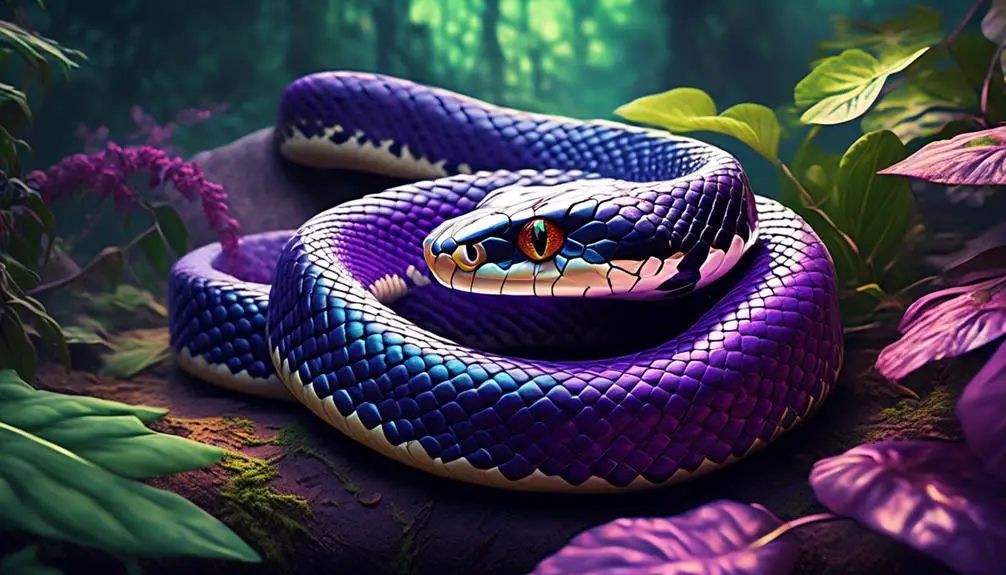
The California Kingsnake (Purple Passion Morph) boasts a stunning coloration that distinguishes it from other members of its species. This particular morph of the California Kingsnake displays a vibrant purple hue, often with contrasting black and white bands. The purple coloration is a result of selective breeding, where breeders have focused on enhancing the intensity of the purple pigmentation.
In terms of physical characteristics, the California Kingsnake (Purple Passion Morph) typically grows to a length of 4 to 5 feet and weighs between 0.9 to 3.3 pounds. It has a lifespan of around 15 to 20 years.
Native to the west coast of North America, the California Kingsnake (Purple Passion Morph) can be found in a variety of habitats including grasslands, woodlands, and desert areas. As a popular pet snake, it’s known for its docile nature and ease of care.
Like other members of the California Kingsnake species, the Purple Passion Morph is a constrictor, meaning it kills its prey by coiling around it and suffocating it. Its diet primarily consists of rodents such as mice and rats.
Ball Python (Purple Passion Morph)
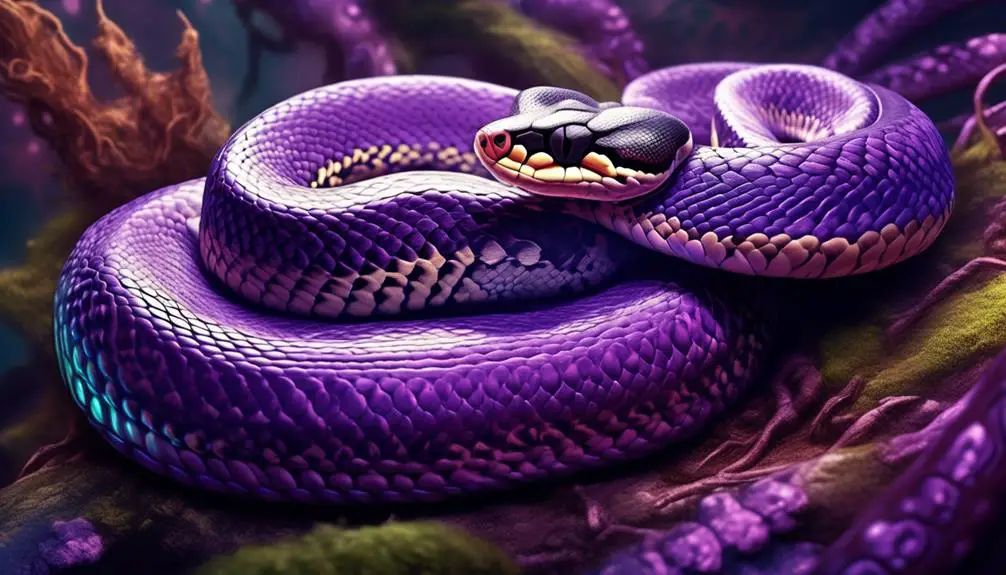
Now let’s turn our attention to the Ball Python, specifically the Purple Passion Morph. This particular morph is known for its unique color variations, with shades of purple and lavender adorning its scales.
Ball Pythons, including the Purple Passion Morph, are highly popular as pets due to their docile nature and manageable size. Their striking appearance makes them a favorite among reptile enthusiasts, adding a touch of vibrancy to any snake collection.
Unique Color Variations
The Ball Python, known as the Purple Passion Morph, exhibits a unique color variation that sets it apart from other snake species. This particular morph displays a striking purple hue, which isn’t commonly seen in snakes. The purple coloration is a result of a genetic mutation that affects the production and distribution of pigments in the snake’s skin.
It’s important to note that the purple coloration doesn’t occur naturally in the wild, but is selectively bred by snake enthusiasts and breeders. The Purple Passion Morph has become highly sought after in the pet trade due to its distinct and captivating appearance.
This color variation adds to the overall diversity and beauty of the Ball Python species.
Popularity as Pets
Ball Pythons with the Purple Passion Morph are highly sought after as pets due to their unique and captivating appearance. These snakes, scientifically known as Python regius, are known for their beautiful purple coloration, which is a result of a genetic mutation. The Purple Passion Morph is characterized by a deep purple or lavender body, with some individuals displaying intricate patterns and variations in shade.
This distinct coloration sets them apart from other ball python morphs and makes them a popular choice among snake enthusiasts. In addition to their striking appearance, ball pythons are relatively docile and easy to care for, making them suitable for both beginner and experienced snake keepers.
With their combination of beauty and ease of care, it’s no wonder that Ball Pythons with the Purple Passion Morph are highly sought after as pets.
Banded Rock Rattlesnake
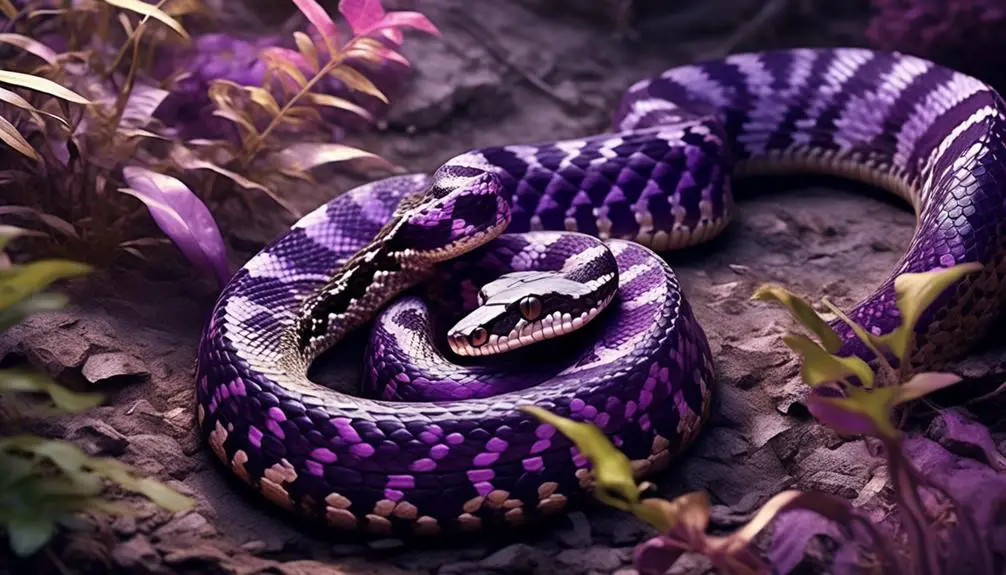
The Banded Rock Rattlesnake, also known as the Green rattlesnake or green rock rattlesnake, is a medium-sized snake native to Southern United States and Mexico. It is characterized by its light gray color and distinctive purple bands. This species, scientifically known as Crotalus lepidus, can grow to be around 25 to 30 inches in length and weigh between 2 to 10 pounds. It has a lifespan of 10 to 20 years and is well adapted to its rocky habitats. The Banded Rock Rattlesnake uses its excellent camouflage to blend in with its surroundings.
The light gray coloration of the Banded Rock Rattlesnake provides an effective disguise in the rocky terrain it inhabits. Its purple bands, which give it its common names, are a unique feature that sets it apart from other rattlesnake species. These bands can vary in width and intensity, ranging from pale lavender to deep purple. The purpose of these bands is still not fully understood, but they may serve as a form of warning or camouflage.
As a member of the Crotalus genus, the Banded Rock Rattlesnake possesses a venomous bite, which it uses to subdue its prey. Its diet primarily consists of small mammals, such as mice, rats, and lizards. Like other rattlesnakes, it has a rattling tail, which it uses as a warning signal when it feels threatened.
Corn Snake
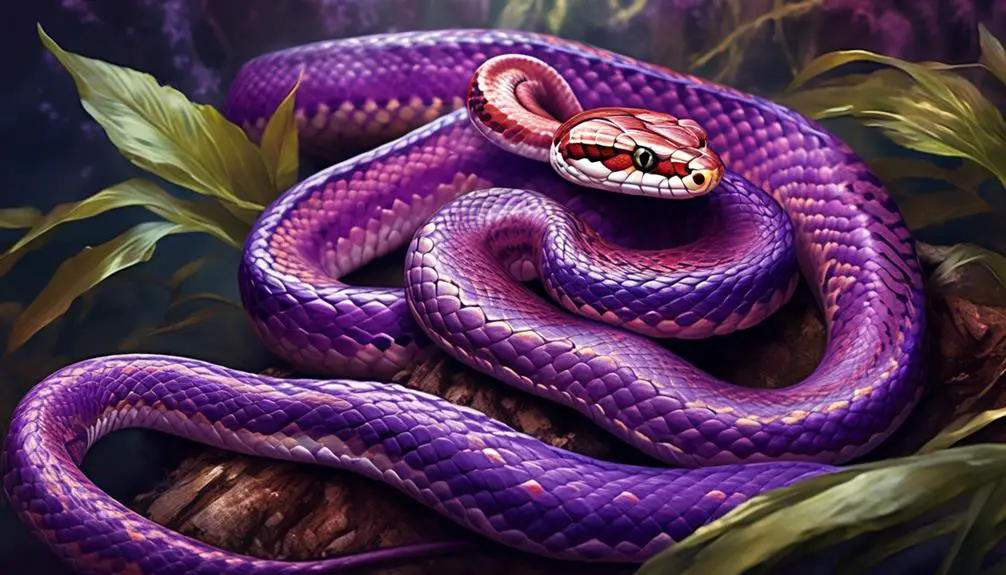
A popular snake species among snake enthusiasts and pet owners, the Corn Snake is known for its vibrant colors and docile nature. Here are some key details about the Corn Snake:
| Corn Snake | |
|---|---|
| Scientific Name | Pantherophis guttatus |
| Common Name | American corn snake |
| Size | 4 to 6 feet (length), 1.6 to 2 pounds (weight) |
| Lifespan | Up to 20 years |
| Appearance | Corn snakes can come in various colors, including orange, red, brown, and even purple. There are morphs of the Corn Snake that exhibit partial purple coloring, adding to their allure. |
| Habitat | Native to the southeastern region of the United States, corn snakes can be found in a variety of habitats such as forests, fields, and grasslands. They are excellent climbers and can be found in trees as well. |
| Diet | Corn snakes are constrictors and primarily feed on small mammals, birds, and reptiles. They are known for their ability to consume rodents as their main food source. |
| Behavior | Corn snakes are generally docile and easy to handle, making them popular pets. They are non-venomous and rarely bite unless they feel threatened. They are also known for their ability to escape enclosures, so proper housing is important. |
| Conservation Status | The Corn Snake is not considered to be a threatened species and is listed as Least Concern by the IUCN. However, habitat loss and collection for the pet trade could potentially impact their populations. |
Reticulated Python (Lavender Albino Morph)
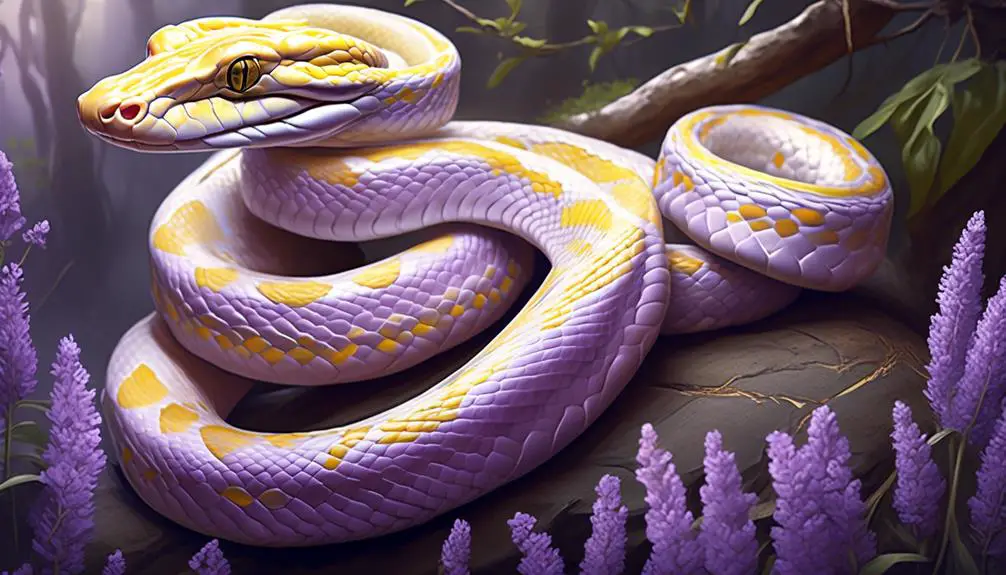
Let’s now explore the fascinating characteristics of the Reticulated Python’s Lavender Albino Morph.
This unique variation of the species showcases a mesmerizing appearance, with a light purple base color and striking orange markings.
Reticulated Pythons are known for their impressive size and weight range, reaching lengths of 12 to 16 feet and weighing up to 150 pounds.
With a lifespan of 12 to 20 years, these Lavender Albino Morphs can be found in various habitats, including forests and savannas.
Lavender Albino Appearance
Lavender Albino morph reticulated pythons exhibit a distinct coloration characterized by a light purple base and vibrant orange markings. This unique appearance is a result of a genetic mutation that affects the production of pigments in their skin cells. The lavender coloration is caused by a reduction in the amount of yellow and black pigments, resulting in a lighter shade of purple.
The orange markings, on the other hand, are due to an increase in the production of red pigments. The combination of these two colors creates a striking and beautiful pattern that sets the Lavender Albino morph apart from other reticulated pythons.
It’s important to note that this coloration isn’t found in wild populations and is only seen in captive-bred individuals that have been selectively bred for this specific trait.
Size and Weight Range
The size and weight range of the Reticulated Python (Lavender Albino Morph) can vary greatly, with individuals typically reaching lengths of 12 to 16 feet and weighing around 150 pounds. These snakes are known for their impressive size and strength, making them one of the largest snake species in the world.
The lavender albino morph of the Reticulated Python displays a beautiful light purple base color with vibrant orange markings. Their long, slender bodies allow them to navigate through various habitats, including forests and grasslands. Despite their large size, reticulated pythons are skilled climbers and swimmers.
They have a lifespan of 12 to 20 years and are highly sought after by snake enthusiasts due to their unique coloration and impressive size.
Lifespan and Habitat
Moving on to the lifespan and habitat of the Reticulated Python (Lavender Albino Morph), let’s explore the fascinating characteristics of this striking snake species.
The Reticulated Python, scientifically known as Malayopython reticulatus, can reach a length of 12 to 16 feet and weigh up to 150 pounds. With a lifespan ranging from 12 to 20 years, this lavender albino morph exhibits a light purple base color with distinctive orange markings.
As for its habitat, the Reticulated Python is found in Southeast Asia, including countries like Indonesia, Malaysia, and the Philippines. It inhabits various environments, such as rainforests, grasslands, and swamps. These impressive snakes are excellent climbers and are known for their ability to swim, making them adaptable to different types of ecosystems.
Neotropical Snail Eater
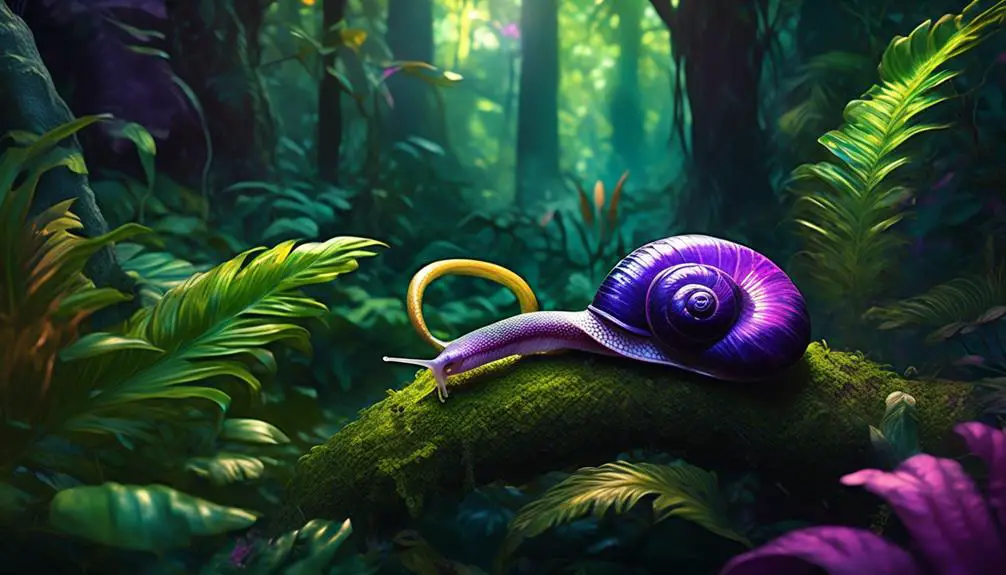
Active at night in forests and plantations, the Neotropical Snail Eater, also known as the Amazonian snail eater or Big-headed snail-eating snake, feeds on snails and slugs. Scientifically named Dipsas indica, this species measures between 1.5 to 2.5 feet in length and has a lifespan of 8 to 10 years. The Neotropical Snail Eater is native to the Neotropical region, which includes parts of South and Central America. It can be found in various habitats such as lowland rainforests, cloud forests, and plantations.
The diet of the Neotropical Snail Eater consists primarily of snails and slugs. Its specialized feeding habits allow it to consume these mollusks whole, thanks to its expandable jaws and muscular throat. The snake uses its enlarged head to grasp and manipulate the snails, breaking their shells and swallowing them whole. This species is known to be nocturnal, actively foraging for its prey during the night. It navigates through the forest floor or climbs vegetation in search of snails and slugs, using its keen sense of smell to locate its preferred food source.
The Neotropical Snail Eater plays an important role in controlling snail and slug populations in its ecosystem. By preying on these mollusks, it helps maintain a balance in their numbers and prevents them from becoming pests. This snake is a fascinating example of the diversity of feeding adaptations found in snakes, showcasing the incredible ability of these creatures to specialize in consuming specific prey items.
Snakes With Partial Purple Coloring
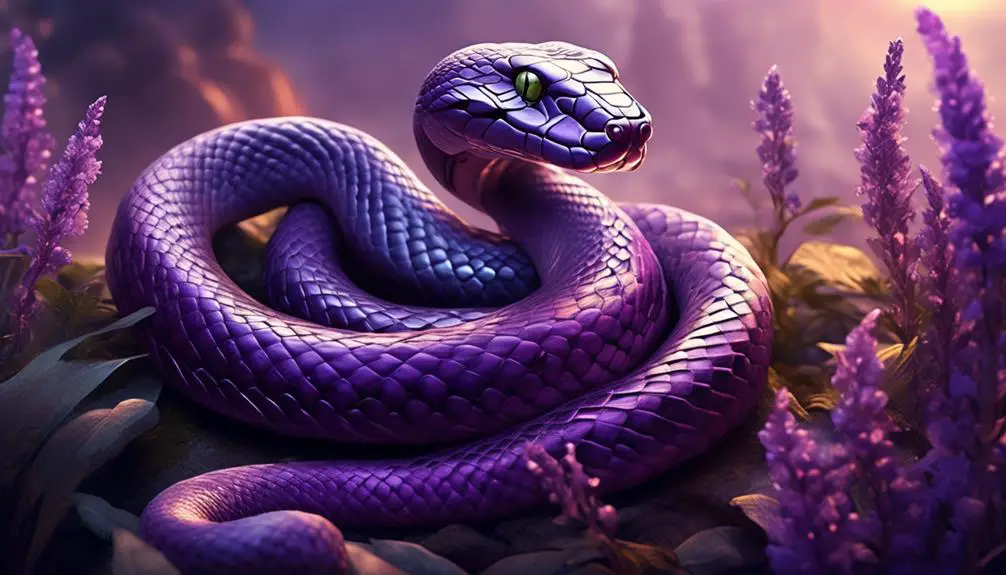
Some snake species exhibit partial purple coloring, adding a unique and captivating aspect to their appearance.
One example is the Corn Snake (Pantherophis guttatus), also known as the American corn snake. This species comes in various morphs, including the lavender corn snake, which displays partial purple coloring. The lavender morph features a light purple base color with darker purple blotches or stripes.
Another snake that showcases partial purple coloring is the Banded Rock Rattlesnake (Crotalus lepidus). This species, native to Southern United States and Mexico, has a light gray body with distinct purple bands.
Additionally, the Reticulated Python (Malayopython reticulatus) offers the lavender albino morph, characterized by a light purple base color and orange markings.
These snakes with partial purple coloring stand out among their counterparts, captivating observers with their unique and striking appearance.
Conclusion
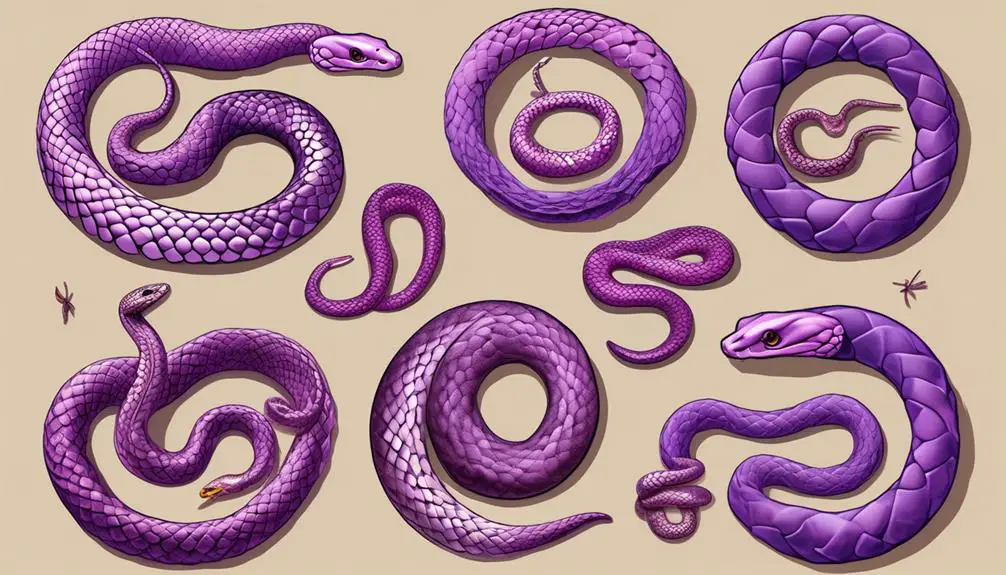
In conclusion, the presence of purple coloring in certain snake species adds an intriguing and visually captivating element to their overall appearance. While purple snakes aren’t as common as those with more traditional colors, such as brown or green, they do exist in nature.
Some examples of real purple snakes include the Cape File Snake, Western Blind Snake, Western Hognose Snake, California Kingsnake (Purple Passion Morph), Ball Python (Purple Passion Morph), Banded Rock Rattlesnake, Corn Snake (Lavender Morph), Reticulated Python (Lavender Albino Morph), and Neotropical Snail Eater. These snakes exhibit varying shades of purple, ranging from vibrant and bold to subtle and pastel. The purple coloring can be seen on different parts of their bodies, such as their scales, patterns, or even their eyes.
While the exact evolutionary purpose of this purple coloring isn’t fully understood, it’s speculated that it may serve as a form of camouflage, communication, or even as a warning signal to potential predators or prey. Further research is needed to fully comprehend the significance of purple coloration in these snake species.

Erzsebet Frey (Eli Frey) is an ecologist and online entrepreneur with a Master of Science in Ecology from the University of Belgrade. Originally from Serbia, she has lived in Sri Lanka since 2017. Eli has worked internationally in countries like Oman, Brazil, Germany, and Sri Lanka. In 2018, she expanded into SEO and blogging, completing courses from UC Davis and Edinburgh. Eli has founded multiple websites focused on biology, ecology, environmental science, sustainable and simple living, and outdoor activities. She enjoys creating nature and simple living videos on YouTube and participates in speleology, diving, and hiking.
- WILDLIFE THEMED T-SHIRTS
Cute Hedgehog Embroidered: Love Wildlife, Protect Nature Wildlife conservation tees
$35.00







